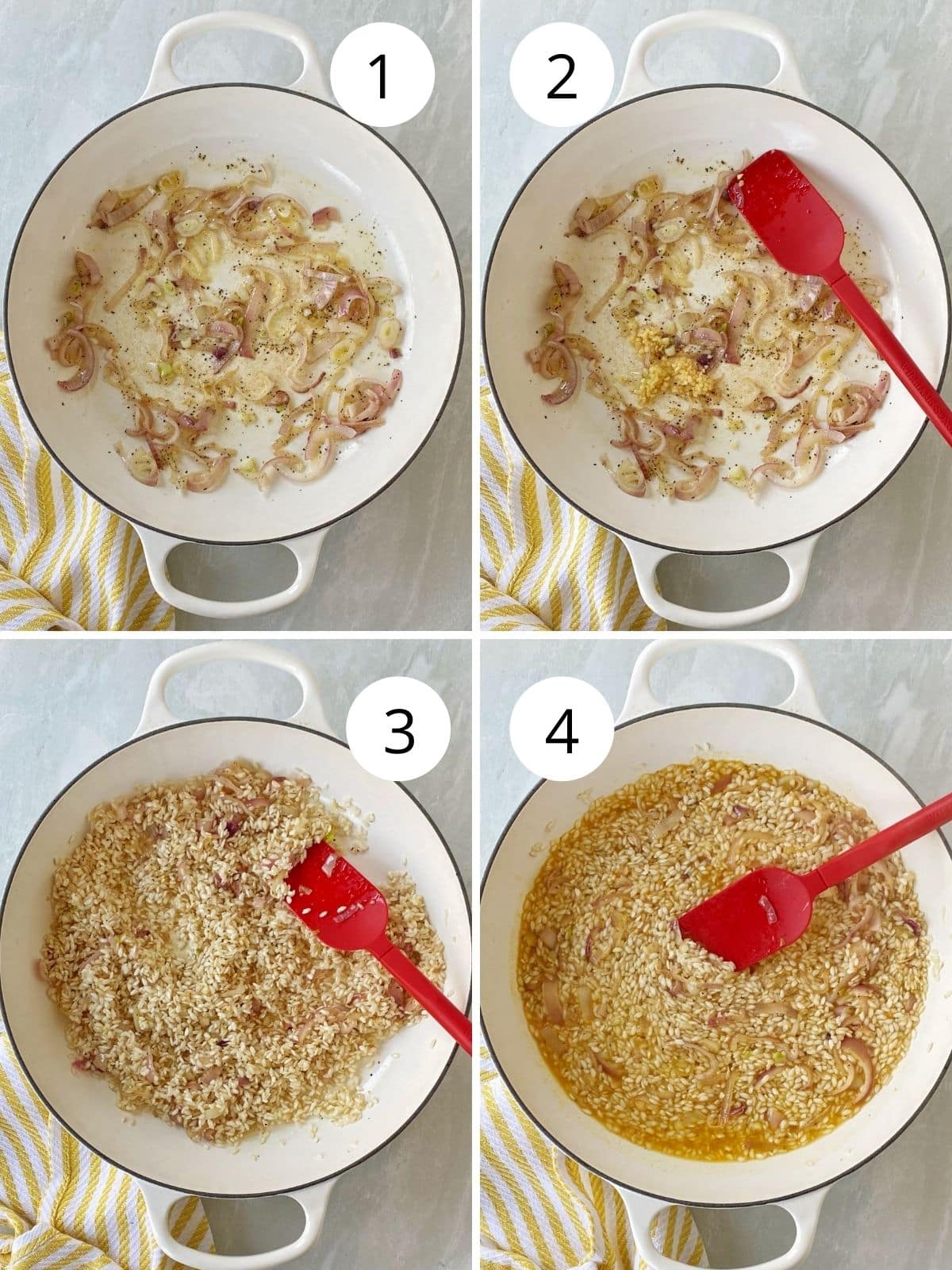Spinach and Artichoke Risotto is inspired by one of my favorite dips. This hearty risotto is rich and creamy and pairs beautifully with beef, chicken, and fish.

Why you will love this
If you love spinach and artichoke, try my Crab Spinach Artichoke Dip and Spinach and Artichoke-Stuffed Portobello Mushrooms.
Ingredients

- Arborio rice is short-grain rice traditionally used in risotto. A slow-cooking process brings out the starch resulting in a creamy dish.
- Broth or stock adds lots of flavor to the rice while cooking. I love using vegetable broth in this recipe, but chicken broth works great too!
- Creamed spinach is my favorite way to incorporate spinach because it adds just the right amount of creaminess. I love using frozen for ease and convenience.
- Artichokes - Canned artichoke hearts are a great staple to keep on hand. Drain then chop or leave quartered.
- Shallots provide a mild, delicate onion flavor. If using sweet or red onions, dice them finely so they infuse a more subtle flavor.
Step-by-step instructions
See the recipe card for complete instructions and ingredient amounts.
- Add the vegetable broth to a saucepan and keep warm over low heat. In a large shallow pan over medium-low heat, cook the shallots in the butter. Season with salt and pepper.
- When the shallots are soft and translucent, add the garlic and cook for another minute.
- Stir in the rice to coat with the butter. Cook for 2-3 minutes to toast the rice.
- Add two ladles of broth to the rice. Cook, stirring occasionally until the liquid has been absorbed.

- When the liquid has been absorbed, add another two ladles. Repeat this process until the rice is tender and creamy, stirring frequently, allowing the liquid to be absorbed before adding more. This process will take 20-25 minutes.
- Meanwhile, thaw the creamed spinach in the microwave. When the rice has absorbed all the liquid, add the spinach, artichoke hearts, and fresh thyme to the mixture. Stir to combine.
- Remove the risotto from the heat and add the Parmesan cheese. Stir together.
- Season to taste with salt and pepper and a squeeze of fresh lemon.

Tips for making risotto
Risotto can seem intimidating, but it doesn't have to be. Here are my tips for a successful risotto every time.
- Be patient. Arborio rice needs 20-25 minutes to cook. If cooked too fast, the rice will not be creamy but al dente. If cooked too slowly, the rice will be gummy.
- Sauté onions, shallots, or leeks for a flavorful base before adding the rice. Garlic and herbs such as rosemary, thyme, or tarragon can also be added for extra flavor.
- Toast the rice in the pan before adding the liquid to lend a nutty flavor.
- Use chicken or vegetable stock, not water, to impart more flavor. Some white wine can be used along with the stock. Replace ½ - 1 cup of stock with white wine.
- Heat the stock before adding to the risotto. Adding cold liquid will slow down the cooking process.
- Stir Parmesan cheese in at the end (off the heat). Cream cheese or mascarpone cheese can also be added at the end for extra richness.

Storing and reheating
Store leftovers in an airtight container in the refrigerator for 3-4 days. Reheat individual portions in the microwave.
Essential tools

Le Creuset 3.5 qt buffet casserole
Buy Now → Buy Now →
Buy Now → 
glass liquid measuring cup set
Buy Now → Buy Now →
Buy Now → Similar recipes
Craving more?
Subscribe to My Casual Pantry to get the latest recipes and ideas sent directly to your inbox.
📖 Recipe Card

Spinach and Artichoke Risotto
Ingredients
- 6 cups low-sodium vegetable broth
- 2 tablespoons butter
- 1 large shallot (sliced)
- ½ teaspoon Kosher salt (divided)
- ½ teaspoon black pepper (divided)
- 1 clove garlic (minced)
- 1 ½ cups Arborio rice
- 10 ounces frozen creamed spinach (thawed)
- 14 ounces canned artichoke hearts (drained and quartered (or chopped))
- 1 teaspoon fresh thyme leaves
- ½ cup grated Parmesan cheese
- ½ lemon (juiced)
Instructions
- Add the vegetable broth to a saucepan and keep warm over low heat. In a large shallow pan over medium-low heat, cook the shallots in the butter. Season with ¼ teaspoon each salt and pepper.
- When the shallots are soft and translucent, add the garlic and cook for another minute.
- Stir in the rice to coat with the butter. Cook for 2-3 minutes to toast the rice.
- Add two ladles of broth to the rice. Cook, stirring occasionally until the liquid has been absorbed.
- When the liquid has been absorbed, add another two ladles. Repeat this process until the rice is tender and creamy, stirring frequently, allowing the liquid to be absorbed before adding more. This process will take 20-25 minutes.
- Meanwhile, thaw the creamed spinach in the microwave. When the rice has absorbed all of the liquid, add the spinach, artichoke hearts, and fresh thyme to the mixture. Stir to combine.
- Remove the risotto from the heat and add the Parmesan cheese. Stir together.
- Season to taste with the remaining salt and pepper and a squeeze of fresh lemon.
Notes
- Be patient. Arborio rice needs 20-25 minutes to cook. If cooked too fast, the rice will not be creamy but al dente. If cooked too slow, the rice will be gummy.
- Sauté onions, shallots, or leeks for a flavorful base before adding the rice. Garlic and herbs such as , rosemary, thyme, or tarragon can also be added for extra flavor.
- Toast the rice in the pan before adding the liquid to lend a nutty flavor.
- Use chicken or vegetable stock, not water, to impart more flavor. Some white wine can be used along with the stock. Replace ½ - 1 cup of stock with white wine.
- Heat the stock before adding to the risotto. Adding cold liquid will slow down the cooking process.
- Stir Parmesan cheese in at the end (off the heat). Cream cheese or mascarpone cheese can also be added at the end for extra richness.
Nutrition
Nutritional information is an estimate and will vary depending upon the exact amounts and specific ingredients used.
This post was originally published in February 2019 and has been updated.











Comments
No Comments